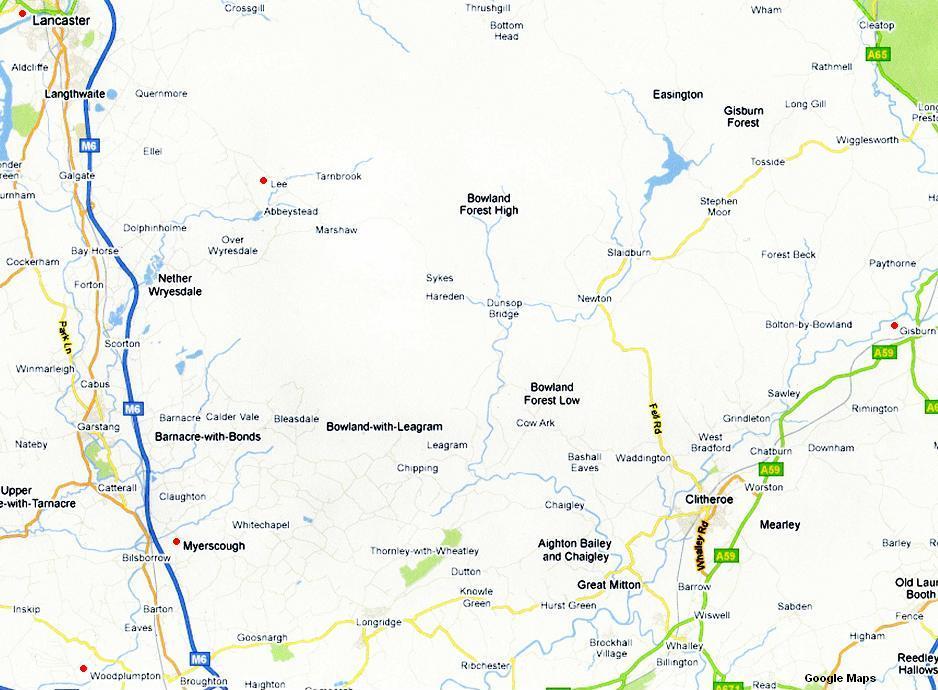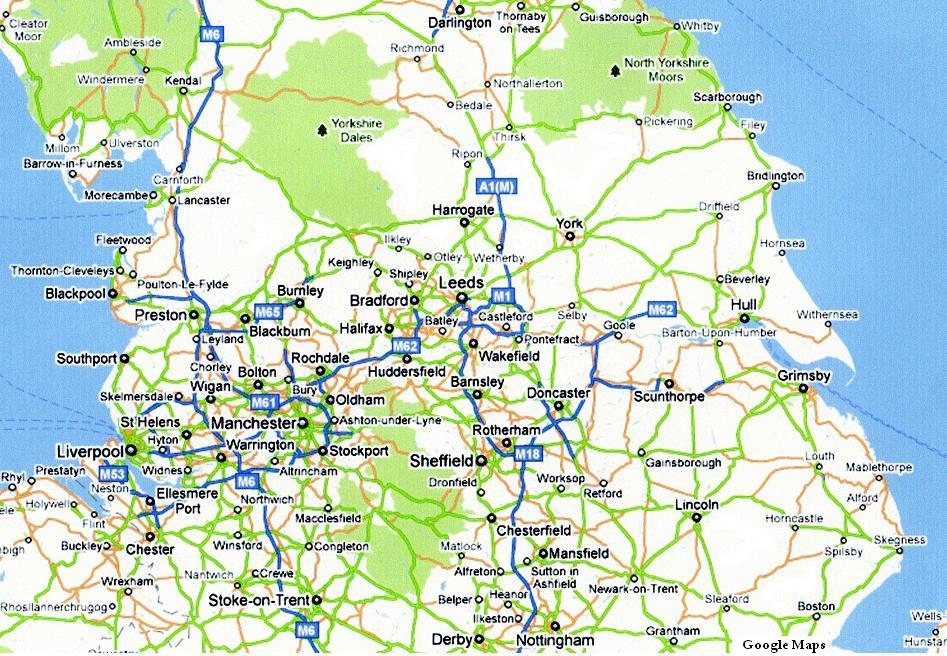Northern Lancashire and Bowland
In fytte one of the Gest, Robin’s men waylay the knight in Barnsdale. His troubles originate with his son (stanza 53):
| He slewe a knyght of Lancaster |
| And a squyer bolde |
In fytte two the knight returns home to ‘Verysdale’, which Holt has identified as Wyresdale to the west of the Forest of Bowland.(1) In fytte five the knight is identified rather cautiously as Sir Richard at the Lee, and in Wyresdale, where the road from Bowland to Lancaster crosses the Wyre, there is the hamlet of Lee. Wyresdale was part of the forest of Lancashire and a family of Legh or La Legh was involved in the administration of the forest, including Wyresdale, but none of them were called Richard. There were long established links between the Yorkshire and Lancashire lands of the Lacys, the honour of Clitheroe in Lancashire, and Pontefract in West Yorkshire, belonged to them. The Lacys also held Bowland from the early twelfth century and Wyresdale was part of the honour of Lancaster, demesne(2) of the crown until granted to Edmund, second son of Henry III, in 1267. The whole area came into single ownership on the death of Henry de Lacy in 1311, when the Lacy estates came by marriage to Thomas earl of Lancaster, Edmund’s son. After the execution of the earl of Lancaster in March of 1322, there were widespread disturbances, and in Lancashire the forest was one of the chief targets. In May when he was at York, Edward II ordered an inquiry into the malefactors who had pillaged his deer and committed other outrages in the counties of Yorkshire and Lancashire. A Scottish invasion prevented further action in 1322 but in July 1323 the investigations were renewed. In September Edward travelled from North Yorkshire to Skipton and then to the manor of Ightenhill, near Burnley in Lancashire, where he stayed from 4 to 13 October. Prior to this, on 20 August special commissioners sat at Clitheroe to receive evidence on the disturbances. Proceedings before the king were opened against the offenders at Wigan, (historically a part of Lancashire), on 22 October when Edward was at the neighbouring manor of Upholland. The pillage of the king’s deer was presented in case after case, and those charged ranged from Sir Roger Leyburn and Sir Robert Holand, down to simple tenants. The raids had occurred in all parts of the forest. In March 1323 the king ordered investigations into the raids which were said to have taken place in his forests of Staffordshire and southern Derbyshire, and there was trouble in the forests of Pickering and Knaresborough in North Yorkshire. The king ordered the arrest of several offenders when he stayed at Pickering in August, and in Knaresborough, one of the foresters was killed.
In fytte seven ‘Edward our comely king’ comes to Nottingham hoping to capture Robin and the knight, and he is concerned about the state of his forests in another location (stanzas 357-8):
| All the passe of Lancasshyre |
| He went both ferre and nere |
| Tyll he came to Plomton Parke |
| He faylyd (missed) many of his dere |
| There our kynge was wont to se |
| Herdes many one |
| He coud unneth (scarcely) fynde one dere |
| That bare ony (any) good horne |
Francis James Child, who followed William Camden, placed Plumpton Park in Cumberland. Joseph Hunter, cautiously followed by Dobson and Taylor, identified it as a well-known park in the forest of Knaresborough. Holt on the other hand, thought that much better sense is made of the passage if it is identified as Plumpton Wood in the Fylde district of Lancashire, and it was within the forest of Lancaster adjacent to the king’s demesne wood of Myerscough.
A Cistercian monastery was established at Kirkstall in west Yorkshire in 1152, it was first founded five years earlier by Henry de Lacy at Barnoldswick, five miles north of Colne, in Lancashire. The monks of Kirkstall also established a grange at Accrington, in Lancashire. They surrendered their estates in Blackburnshire, an ancient division of the county of Lancashire, to Henry de Lacy in 1287 in return for an annual rent, but they still drew one mark annually from the revenues of Clitheroe. In about 1180, Robert de Lacy gave the monks of Kirkstall an acre of land and buildings at Wentbridge immediately to the west of the bridge. All of the monk’s interests, through their dependence on the Lacys, spanned the whole of the area on which the legend of Robin Hood drew for its names and locations, except for Sherwood.
The ‘Edward our comely king’ of the Gest was concerned about the state of the forest in Lancashire, and so was Edward II during his northern visitation of 1322-3; both ended their northern progress at Nottingham. It seems likely then, that Edward II’s response to the attack on the forests of Lancashire was the basis for the story of ‘Edward our comely king’ in fytte seven of the Gest. It also seems likely that the Lacy family and Thomas earl of Lancaster, played some part in the Yorkshire and Lancashire elements.
1. The village of Gisburn about ten miles from Wyresdale, to the east of Bowland forest, is probably from where the villain in Guy of Gisborne takes his name.
2. Demesne: lands held in one’s own power.
This page contains information found in Robin Hood, Holt, pp. 100-106.

|

